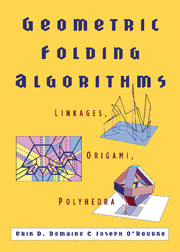Book contents
- Frontmatter
- Contents
- Preface
- 0 Introduction
- Part I Linkages
- 1 Problem Classification and Examples
- 2 Upper and Lower Bounds
- 3 Planar Linkage Mechanisms
- 4 Rigid Frameworks
- 5 Reconfiguration of Chains
- 6 Locked Chains
- 7 Interlocked Chains
- 8 Joint-Constrained Motion
- 9 Protein Folding
- Part II Paper
- Part III Polyhedra
- Bibliography
- Index
5 - Reconfiguration of Chains
Published online by Cambridge University Press: 07 September 2010
- Frontmatter
- Contents
- Preface
- 0 Introduction
- Part I Linkages
- 1 Problem Classification and Examples
- 2 Upper and Lower Bounds
- 3 Planar Linkage Mechanisms
- 4 Rigid Frameworks
- 5 Reconfiguration of Chains
- 6 Locked Chains
- 7 Interlocked Chains
- 8 Joint-Constrained Motion
- 9 Protein Folding
- Part II Paper
- Part III Polyhedra
- Bibliography
- Index
Summary
After seeing that many fundamental linkage reconfiguration problems are intractable, we specialize in this chapter to the simplest situations, where polynomial-time—sometimes even linear-time—algorithms are possible.
We start in Section 5.1 by exploring from Table 1.1 the simpler end of each spectrum: the simplest linkage graph stucture, an open chain; the simplest intersection constraints, none; the simplest dimension, 2D; and the simplest problem, reachability. In Section 5.2 we continue to permit the chain to cross itself, but not a surrounding boundary. Finally, we initiate the exploration of reconfigurations of chains that avoid self-intersection in Section 5.3, saving the richest topic (locked chains) for Chapter 6.
RECONFIGURATION PERMITTING INTERSECTION
Chain Reachability
Let C be an open chain of n edges/links ei, with lengths |ei| = ℓi i = 1, 2,…, n, and with n + 1 vertices/joints v0,…, vn so that ei = vi−1vi (see Figure 5.1). Such a pinned chain is often called an arm (or “robot arm”), with v0 the shoulder joint and vn the hand. Fix v0 at the origin of a coordinate system.
Connectivity of Configuration Space
The configuration space of this arm C is certainly connected. From any configuration with n ≥ 2links, we can rotate the last link en to become a collinear extension of the next to-last link en−1. Then the arm can be viewed as an arm with one fewer link, treating the last two links en−1 and en as fused together into a single “virtual link” of length ℓn−1 + ℓn.
Information
- Type
- Chapter
- Information
- Geometric Folding AlgorithmsLinkages, Origami, Polyhedra, pp. 59 - 85Publisher: Cambridge University PressPrint publication year: 2007
